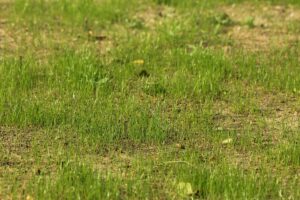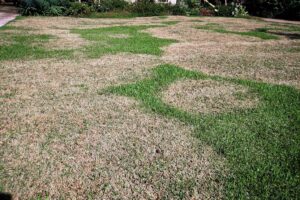From Drought to Downpour: Spring Turf Care Tips for York County, SC
Spring in York County, South Carolina, is always unpredictable and 2025 has remained on trend for the weather roller coaster. Residents in towns like Rock Hill, Fort Mill, Clover, and York began May with a concerning drought. Grass turned brittle, soil cracked, and irrigation systems were pushed to their limits. Just as everyone began praying for rain, the skies opened—bringing days of heavy thunderstorms, flooding rains, and even hail.
If your lawn looks confused, tired, or beat-up, you’re not alone. And this rollercoaster weather is exactly why spring turf care is more than just mowing and watering—it’s about building resilience in your lawn so it can survive and thrive through the chaos.
Let’s explore how these extreme spring conditions affect your turf—and what you can do now to protect and restore your lawn across York County.
🌵 Spring Drought: How It Stressed Your Lawn

Drought conditions hit many parts of York County hard in early May. Homeowners in Tega Cay, Lake Wylie, and McConnells noticed telltale signs:
Grass blades curling or turning brown
Soil pulling away from edges or roots
Patchy or thinning areas
Turfgrass, especially cool-season varieties like fescue, struggles under prolonged dry stress. Without moisture, grass goes dormant or dies back. Compacted soil, poor nutrient uptake, and heat stress start to compound—and suddenly your yard becomes more vulnerable to weeds, pests, and erosion.
What Spring Turf Care Can Do:
Core aeration allows water and nutrients to penetrate deeply again.
Topdressing with compost can boost soil health and help retain moisture.
Fertilizer timing helps stimulate root regrowth once the rains return.
☔ Then Came the Rain: Saturated Lawns & New Risks
Just as drought-weary lawns needed water—they got too much of it. Downpours swept through Newport, Sharon, and Hickory Grove, causing soil saturation, pooling, and runoff. This “water overload” brings a new set of problems:
Fungal turf diseases thrive in damp conditions.
Grass roots may suffocate or rot in compacted, soggy soil.
Nutrients are leached away, leaving lawns hungry and yellowed.
Some lawns even showed erosion on slopes or around walkways—meaning the soil itself has been disrupted.
What Spring Turf Care Can Do:
Disease prevention treatments protect against brown patch and other fungal infections.
Soil amendments like gypsum can help with compaction and drainage.
Slow-release fertilization replenishes what was lost to runoff.
🌩️ The Knockout Punch: Hail & Storm Damage
Several neighborhoods around Rock Hill and York saw hailstorms—rare but damaging. Hail can bruise or shatter grass blades, compact soil further, and cause visible turf scarring. Add in high winds and debris, and your yard may have more damage than meets the eye.
Hail impact can weaken turfgrass’ ability to photosynthesize, stunt growth, and open wounds that invite disease or pests.
What Spring Turf Care Can Do:
Mowing recovery protocols (e.g., blade height adjustment) help stressed grass rebound.
Overseeding can thicken bare spots damaged by hail or storm runoff.
Customized turf inspections identify hidden injuries needing treatment.
💡 How Weather Affects Turf Differently Across York County
Spring weather doesn’t strike evenly across the county. Here’s a quick breakdown of how some key towns were affected—and how Hippo Turf Care tailors treatments accordingly:
Rock Hill, SC: Dense neighborhoods with compacted soils saw water runoff and standing water. Turf care here focuses on aeration, drainage, and soil rejuvenation.
Fort Mill, SC: Lawns in newer developments suffered from drought stress due to poor root establishment. Soil conditioning and root stimulations are vital here.
Lake Wylie, SC: Near the lake, homeowners faced flooding and erosion. Topdressing and slope-stabilizing strategies can help restore turf integrity.
York, SC: Hail and wind damage left lawns scarred. Overseeding and turf healing protocols are recommended.
Clover, SC: A mix of weather extremes calls for comprehensive spring turf care programs, including fungal prevention, fertilization, and pest control.
🧠 Why DIY Isn’t Enough in Weather Extremes
Many homeowners feel confident managing mowing and watering, but extreme spring weather exposes the limits of DIY lawn care. Here’s why calling the pros matters:
Timing is critical: Applying fertilizer or pre-emergent too soon after rain or too late after drought ruins effectiveness.
Diagnosis matters: Brown spots could be drought, fungus, hail injury, or compacted roots. Professional turf care identifies the root cause.
Treatment is precise: Hippo Turf Care uses calibrated spreaders, soil testing, and expert know-how to avoid costly mistakes.
🌱 What’s Next? Your Spring Turf Care Checklist
Here’s what homeowners across York County should be doing right now:
Book a soil inspection to assess for your lawn’s damages and needs.
Apply appropriate spring fertilization based on turf type and recent weather.
Monitor for fungal activity and act fast with professional-grade treatments.
Repair hail damage and erosion through overseeding or topdressing.
Plan for proactive summer protection, especially if forecasts call for heat.
📞 Call the Local Lawn Experts Who Know York County

Spring in the Carolinas is beautiful—but also brutal on lawns. That’s why Hippo Turf Care is here. We live and work in York County, and we’ve seen firsthand how this season’s wild weather has tested local turf.
Our customized spring turf care programs are designed to help your lawn recover, rebuild, and get ready for summer. Whether you’re in Rock Hill, Fort Mill, York, Lake Wylie, or beyond, we’ve got your back (and your grass).
👉 Call Hippo Turf Care today at 803-810-1145
Let’s get your lawn healthy, strong, and storm-proof.







